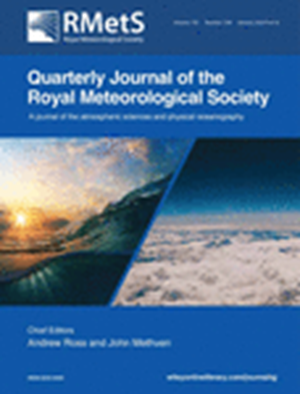Assessment of short‐range forecast error atmosphere–ocean cross‐correlations from the Met Office coupled numerical weather prediction system
IF 3
3区 地球科学
Q2 METEOROLOGY & ATMOSPHERIC SCIENCES
引用次数: 0
Abstract
Operational data assimilation systems for coupled atmosphere–ocean prediction are usually “weakly coupled”, in which there is no explicit interaction between the atmosphere and ocean within the data assimilation step. Explicitly allowing for cross‐correlations between the ocean and the atmosphere may have potential benefits in improving the consistency of atmosphere and ocean analyses, as well as allowing a better use of observations at the interface. To understand whether such correlations are significant on the time‐scales of numerical weather prediction, we investigate the atmosphere–ocean cross‐correlations of short‐term forecast errors from the Met Office coupled prediction system, considering their temporal and spatial variability. We find that significant correlations exist between atmosphere and ocean forecast errors on these time‐scales, and that these vary diurnally, from day to day, spatially and synoptically. For correlations between errors in the atmospheric wind and ocean temperature, positive correlations in the North Atlantic region are found to be synoptically dependent, with correlation structures extending into the ocean throughout the deep mixed layer, beyond a depth of 100 m. In contrast, negative correlations over the Indian Ocean are very shallow and are associated with the diurnal cycle of solar radiation. The significance and variability of cross‐correlations indicates that there should be a benefit from including them in data assimilation systems, but it will be important to allow for some flow‐dependence in the correlations. Furthermore, the differing vertical extents of the cross‐correlations in different regions implies the need for situation‐dependent localisation of ensemble correlations when including them in coupled data assimilation systems.气象局耦合数值天气预报系统对大气-海洋交叉相关性短程预报误差的评估
用于大气-海洋耦合预报的业务数据同化系统通常是 "弱耦合 "的,即在数据同化步骤中,大气和海洋之间没有明确的相互作用。明确允许海洋与大气之间的交叉相关性,可能会提高大气和海洋分析的一致性,并更好地利用界面上的观测数据。为了了解这种相关性在数值天气预报的时间尺度上是否显著,我们研究了气象局耦合预报系统的短期预报误差的大气-海洋交叉相关性,并考虑了它们的时空变异性。我们发现,在这些时间尺度上,大气和海洋预报误差之间存在明显的相关性,而且这些相关性在昼夜、日与日之间、空间和同步上都有变化。就大气风和海洋温度误差之间的相关性而言,我们发现北大西洋地区的正相关性与同步相关性有关,相关结构延伸到海洋的整个深混合层,深度超过 100 米。与此相反,印度洋上空的负相关很浅,与太阳辐射的日周期有关。交叉相关性的重要性和可变性表明,将交叉相关性纳入数据同化系统应该是有益的,但重要的是在相关性中考虑到一定的流动依赖性。此外,不同地区交叉相关的垂直范围不同,这意味着在将集合相关纳入耦合数据同化系统时,需要根据情况对集合相关进行定位。
本文章由计算机程序翻译,如有差异,请以英文原文为准。
求助全文
约1分钟内获得全文
求助全文
来源期刊
CiteScore
16.80
自引率
4.50%
发文量
163
审稿时长
3-8 weeks
期刊介绍:
The Quarterly Journal of the Royal Meteorological Society is a journal published by the Royal Meteorological Society. It aims to communicate and document new research in the atmospheric sciences and related fields. The journal is considered one of the leading publications in meteorology worldwide. It accepts articles, comprehensive review articles, and comments on published papers. It is published eight times a year, with additional special issues.
The Quarterly Journal has a wide readership of scientists in the atmospheric and related fields. It is indexed and abstracted in various databases, including Advanced Polymers Abstracts, Agricultural Engineering Abstracts, CAB Abstracts, CABDirect, COMPENDEX, CSA Civil Engineering Abstracts, Earthquake Engineering Abstracts, Engineered Materials Abstracts, Science Citation Index, SCOPUS, Web of Science, and more.

 求助内容:
求助内容: 应助结果提醒方式:
应助结果提醒方式:


